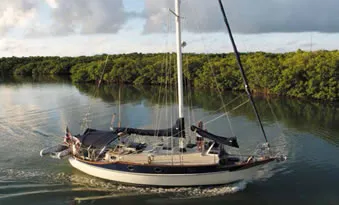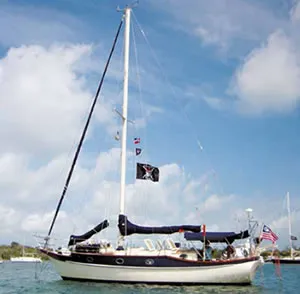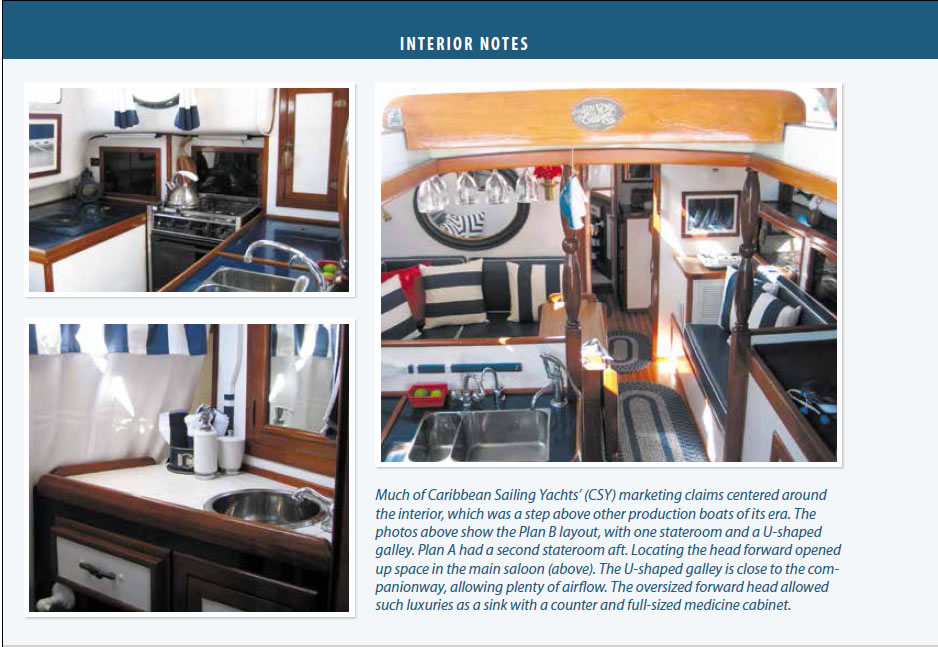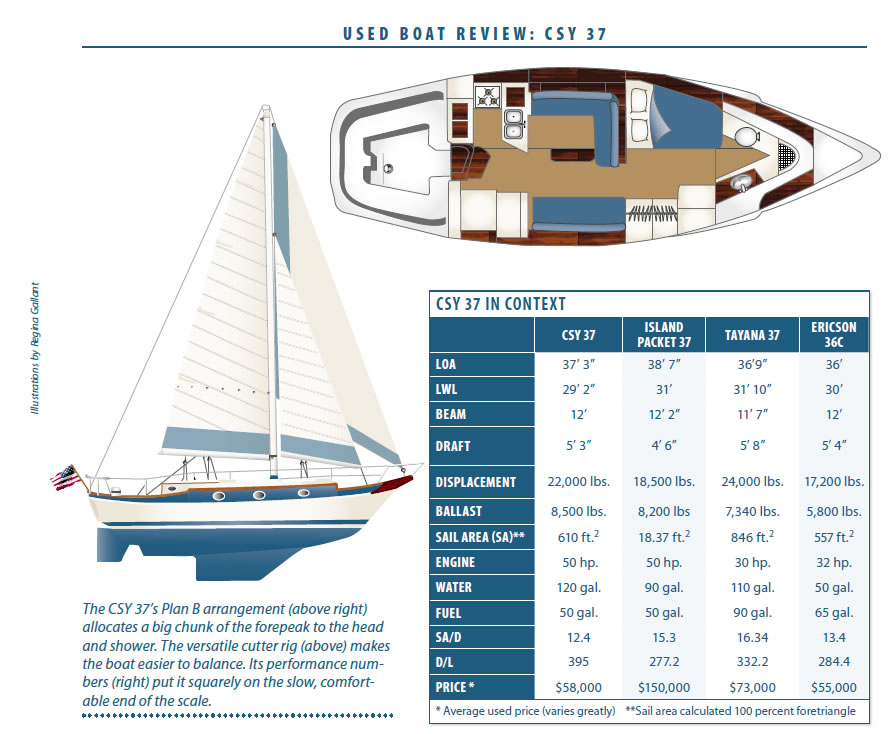
Photos by Peter Hibbard
Designed by Peter Schmitt, the CSY 37 is the mid-sized boat in the CSY line. Eighty-seven of these raised-deck cutters were built, primarily for the Caribbean bareboat charter trade.
Schmitt has combined some features most often found in traditional boats-the oval stem, raised deck, and semi-clipper bow-with a relatively modern underbody featuring a fairly long fin keel and a skeg-mounted rudder. On paper, the boat looks pretty good. In person, she is rather tubby and high-sided, but that tubbiness means added buoyancy-not such a bad thing to have in a blow.
The CSY 37 most closely resembles the Ericson Cruising 36. The styling of both these boats can best be described as ersatz traditional.
Even with the tall rig and deeper keel options, the CSY 37 is no performance cruiser. In our owner surveys, the people most satisfied with the boats performance had tall rigs, but even they agreed that this was an all-out cruising boat. Unfortunately, with her huge cockpit, she is not an ideal sea boat. Rather, she is a boat designed for a specific purpose, bareboat chartering, a purpose which she serves admirably. To expand her appeal to the general sailing public would be difficult, as CSY discovered. The company went under in 1981, a tough period for many builders.
Most CSY 37s went into charter service, usually on lease-back arrangements. The boats have to be strong and reliable-a week out of service for repairs means lost revenue to the charter operator. That the boats can stand up to this constant use and abuse is a credit to both designer and builder.
Deck Layout
With her raised deck amidships, the CSY 37 has an amazing amount of deck space, giving the on-deck impression of a small ship. There is plenty of space on deck to carry a rigid dinghy. Schmitts own CSY 37 carried a beautiful little dory with a varnished transom as a tender; she fit quite neatly on the starboard side and served as a catchall for fenders and lines.
Deck space is important in boats used extensively in the charter trade. Lounging on deck is the primary charter boat activity. In this category, the CSY 37 gets five stars.
Anchor handling is fairly easy with the stub bowsprit. There is, however, only a single bow cleat. This is a Practical Sailor pet peeve, for it greatly complicates anchoring with two anchors, a common practice for cruising boats. The original anchoring package included a good length of stainless-steel chain, if you encounter this ditch it quick; use galvanized instead.
The boat came with a rugged horizontal electric windlass from the Ideal windlass company. Many of these are still in service and worth repairing, but a more practical option may be to replace it with a manual windlass or a newer model (see PS October 2008 online).
Heavy travelers for both the main and the staysail are located on the main deck. Athwartships control lines should really be used with these to get optimum performance from the sails-essential on a boat that must be tweaked to get a reasonable level of performance on the wind.
The cockpit is huge-undesirable for an offshore boat but good for the charter trade. The large cockpit lockers are well divided and are partitioned from the engine space under the cockpit.
The starboard cockpit locker contains the best battery box installation we have seen on a stock boat of this era.
The port locker contains the optional 110-VAC refrigeration compressor. Unfortunately, its wiring is exposed to the weather when the locker lid is opened. The sound-insulated engine room hatch occupies much of the cockpit sole.
There are four large cockpit scuppers, which are imperative to have with the huge cockpit. The companionway sill should be higher if the boat is to be used offshore. Some owners have commented that water backs up through these scuppers, a problem easily remedied by swapping the hoses, so the port scuppers drain to starboard, and vice versa. A fiberglass seahood, protecting the forward end of the companionway slide, is standard equipment.
Interior
Two interior arrangements are available, a two-stateroom, two-head plan, and a single-stateroom, single-head plan. The two-stateroom plan is used primarily in the charter trade. It is really too much interior to try to cram in a 29-foot waterline and designer Schmitt was not particularly proud of it.
The single-stateroom layout is also unconventional. It gives over the forward 40 percent of the interior space to a large cabin with built-in double berth and a huge head compartment in the forepeak. The problem with this arrangement is that should you have guests aboard, they must troop through the owners cabin in order to use the head.
The space given over to the head in the single-stateroom model is almost exactly the same space occupied by the forward cabin in the two-stateroom model. With a single-stateroom layout, interior space might have been better utilized with a conventional layout of sleeping quarters forward with the head and hanging lockers dividing the forward cabin from the main cabin. That said, there is some practical aspect to allocating the least comfortable part of the boat to the toilet and shower, which see infrequent use.
The interior volume of the CSY 37 is huge, thanks to the raised deck. There are many well-thought-out interior details, too many to catalog here. The ice box, for example, is divided into two compartments with separate opening traps. The icebox has a minimum of 4 inches of urethane foam insulation, probably more than any other stock boat on the market of this era.
There are, however, lapses in this good design. Galley countertops in our test boat were covered with a slate-like laminate, difficult to clean and too bumpy for a good work surface. Head counters and some shelves were covered with marble-grained plastic, looking more like a slice out of a multicolored bowling ball than real marble.
The mixture of excellent design details, strange lapses in taste, and irregular execution is difficult to evaluate reasonably. It was pleasing to see, that after years of using teak-grained, mica-covered bulkheads, CSY switched to real oak-faced bulkheads.
As could be expected of a boat designed for the Caribbean charter trade, ventilation of the interior is excellent. There are six opening hatches or skylights in addition to the companionway. Some dorade boxes, however, might be welcome in steamy climates with frequent rain. One could spend a great deal of time analyzing the interior details, primarily because a lot of thought has gone into them. Both of the interior layouts are unusual, and each will have adherents and detractors.
Construction
There are really only two words to describe the construction of the CSY 37: massive overkill. This is a mixed blessing. It means you have a strong, heavy hull. It often also means that you end up with a boat that is under canvassed in light air. Very often, such an approach means a boat that has a fairly low ballast-to-displacement ratio.
Forty percent of the CSY 37s advertised displacement is in the ballast keel. With a 29-foot waterline, the displacement of about 20,000 pounds is average by traditional standards, heavy by modern standards.
The hull is an extraordinarily heavy, solid-glass layup, as is the deck-almost never seen today. No core materials are used anywhere. Without coring such as balsa or Airex, a glass hull can sweat in a cold climate and be excessively warm in a hot, humid climate.
The hull-to-deck joint is simple and effective. The hull and deck flanges, which overlap to form a molded rail, are bedded in 3M 5200 and through bolted with stainless-steel machine screws on 4-inch centers. The ubiquitous 3M 5200 is a tenacious adhesive sealant, and hull-deck leaks do not seem to be an issue with this boat.
Keel construction is unusual. The cast-lead keel is glassed into the hollow keel molding, any voids being filled with fiberglass slurry. This is then glassed over to form a double bottom and to keep the ballast in place. This ballast arrangement is identical in both the shoal and deep-draft versions. The deep-draft boat, however, has a 16-inch deep keel extension filled with about 600 pounds of cast concrete. A few CSY 37s have undergone a do-it-yourself keel-ectomy in which this extension is cut off. The shoal draft boat with less lateral plane will, of course, make more leeway.
The hull is molded in two pieces, then joined in the middle with heavy overlapping layers of mat and roving. This allows some flexibility in hull design, making possible such features as a molded-in rubbing strake and a stern with substantial tumble home.
Installation of hardware is excellent. This is one of the few production boats from this era we have ever seen with through-bolted bronze seacocks. Backing plates are used on deck hardware such as cleats and winches.
The rudder stock is a solid 2-inch round bronze bar. The cast-bronze rudder heel fitting would look more at home on a 60-foot boat than on a 37-footer. The rudder straps are also bronze, rendering the boat immune from the problems with encapsulated 304 stainless steel found in some rudders of this era.
The bow fitting is a massive stainless steel weldment, incorporating an anchor roller, a welded chock, and the headstay chainplate. The edges of the bow chock are not rounded, and could easily chafe an unprotected anchor rode. This bow fitting could double as an effective battering ram. We suspect that the dock boys in the West Indies were pretty wary every time an inexperienced charterer brought one of the CSY charter boats into the slip.

The chainplates are heavy stainless-steel flat bars with load-distributing welded webs through-bolted to the hull. The hull layup is further reinforced in the way of the chainplates, an almost extraneous precaution, given the extreme heaviness of the regular hull layup.
Interior bulkheads are heavy waterproof plywood, attached to the hull with solid and neatly made fillets. Airex pads along the outboard edges of the bulkheads distribute the bulkhead stresses on the inside of the hull, preventing hard spots.
Cabin sole supports are clear fir. The teak-faced cabin sole is screwed to these bearers, with only limited access openings to the bilge. Practical Sailor would prefer that most of the cabin sole be removable, providing access to the bilge spaces in an emergency. CSY appeared to be counting on the massiveness of the hull construction to prevent holing. This conceit could backfire. Remember the Titanic?
Hatches are molded fiberglass with translucent panels. They have good gasketing and good hold-downs, but a short person will have trouble reaching overhead to open the hatches due to the tremendous headroom.
The boats exterior finish is of good stock boat quality. Joinerwork is clean with the exception of an awkward transition from the caprail on top of the raised deck to the sheer-level railcap in the foredeck well.
The molded fiberglass trailboards are shielded below the bow by a somewhat awkward molded glass panel. This became standard after a number of CSY boats lost their trailboards in heavy seas.
Handling Under Power
With such high topsides, the Perkins 4-108 is the smallest engine we would want in the boat. As it is, handling at slow speeds in a crosswind can be tricky. A great deal of practice is required to handle such a high-sided boat under power in a breeze.
The turning radius of the CSY 37 is substantially larger than with a shorter-keeled boat. With her heavy displacement, acceleration is not exactly neck snapping. She should have enough power to get out of tight spots, however.
Handling in reverse is tricky. The boat does not go where you aim it until you learn to use a combination of rudder and bursts of throttle.
Engine access through the large cockpit hatch is good, but the heavy hatch should have a more positive means of holding it in the upright position. If it fell on your head, youd remember it, if you were lucky enough to then remember anything.
To those who have been spoiled by the handling under power of some modern boats, the CSY 37 may be a disappointment.
Handling Under Sail
The CSY 37 was available in two keel configurations, and with two rigs. The four possible combinations offer very different performance characteristics.
Most boats were delivered with the standard short rig. In areas of normally heavy air, such as the West Indies in winter, the normal rig is adequate. In light air with the short rig, the boat is a slug. The engine will come in handy under these circumstances.
Performance is greatly enhanced by the tall rig, which is about 8 feet taller than the standard rig and incorporates two sets of spreaders.
With the chainplates set at the outboard edge of the hull, the sheeting base is excessively wide. Sheeting a genoa in tight enough to go to windward effectively is difficult.
To avoid the necessity for running backstays, the intermediate and after lower shrouds are attached to the deck several feet aft of the mast and the upper shrouds. Unfortunately, when broad reaching, the boom and main fetch up on these shrouds far too soon. This is ironic in a boat whose best point of sail is off the wind.
Our test boat had the tall rig and the shoal-draft keel. This is not the combination we would choose to own. Performance with the tall rig is greatly enhanced. However, the higher sail plan does make the boat more tender, and with the cut-down keel, combines to produce a boat that makes excessive leeway when heeled more than about 20 degrees. We would prefer to combine the tall rig with the deep keel.
Our test boat was overpowered with full main, staysail, and large yankee by gusts of a little over 15 knots over the deck, sailing hard on the wind. She also made substantial leeway. With a reef in, the helm eased, the boat stood up, and leeway was less.
Off the wind, the CSY 37 comes into her own. She is stable, and visions of long tradewind passages instantly come to mind. Under those conditions, she would shine if you had plenty of chafe protection on those aft-leading shrouds.
Halyard winches are mounted on the keel-stepped, painted aluminum mast. The boom does not overhang the cockpit, and has a well-made boom gallows, which provides a good handhold on deck as well as an excellent place to store the boom when at rest, or when sailing under the storm jib alone in heavy weather.
Conclusions
CSY was an unusual company, and the CSY 37 is certainly an unconventional boat. The boat is strongly built-overly built, in fact. The price may seem high, until you consider that this is a well-equipped 20,000-pound boat. Hot and cold pressure water, Edson pedestal steering, and gimballed propane stove were all standard, for example.
CSY boats were probably the strongest production boats ever marketed. They may be ungainly, and not the hottest performers under sail, but they are tough. Thats an important consideration if youre trying to get the most for your money.
Editors note: This review is an updated and expanded version of one first published in 1998.





































Take me back to the 70s. So many cool sailboats to choose from. Truly the golden age.